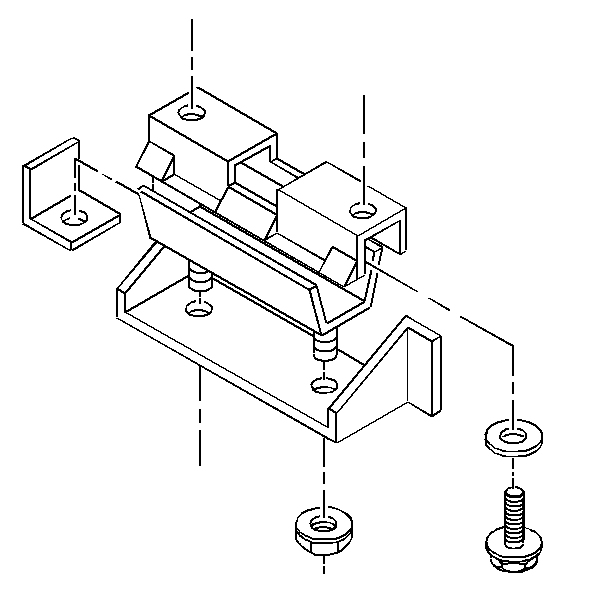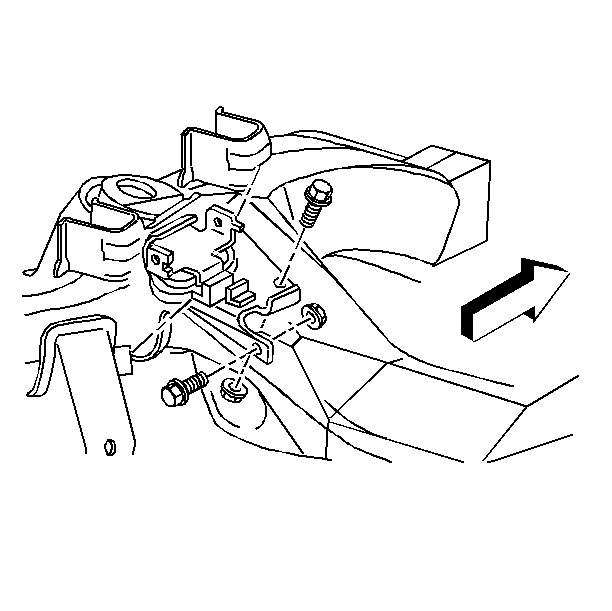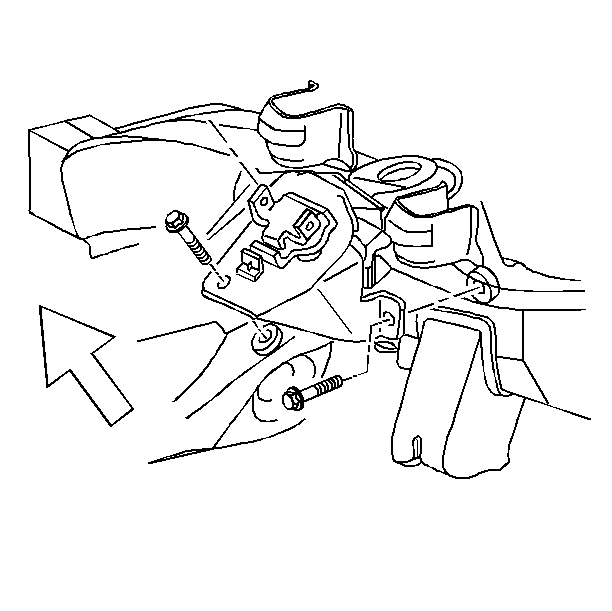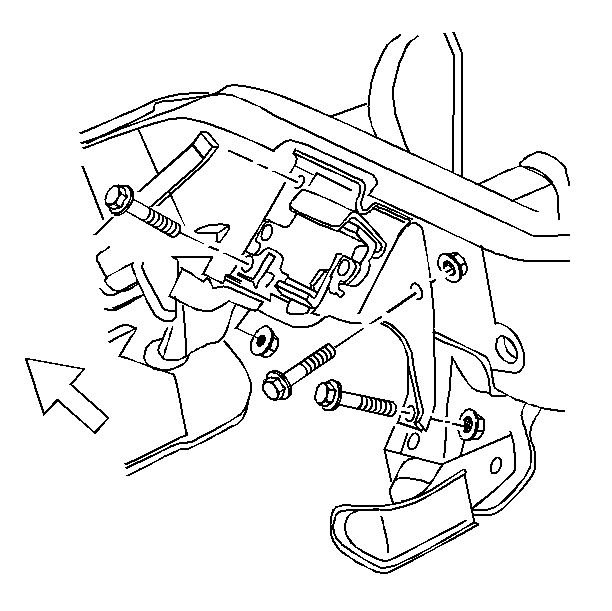Engine Mount Replacement Front Bracket
Removal Procedure
- Support the engine with a suitable lifting fixture, such as a cherry picker. Do not load the engine mounting.
- Remove the engine mounting through-bolt and nut.
- Raise the engine only enough to permit removal of the engine mounting bracket.
- Check for interference between the rear of the engine and the dash panel.
- Remove the engine mounting bracket bolts and the washers.
- Remove the engine mounting bracket.

Installation Procedure
- Install the engine mounting bracket.
- Install the engine mounting bracket, bolts and washers.
- Lower the engine until the engine mounting through-bolt can be inserted. Install the through-bolt.
- Install the nut.

Tighten
Tighten the bolts to 59 N·m (44 lb ft).
Notice: Use the correct fastener in the correct location. Replacement fasteners must be the correct part number for that application. Fasteners requiring replacement or fasteners requiring the use of thread locking compound or sealant are identified in the service procedure. Do not use paints, lubricants, or corrosion inhibitors on fasteners or fastener joint surfaces unless specified. These coatings affect fastener torque and joint clamping force and may damage the fastener. Use the correct tightening sequence and specifications when installing fasteners in order to avoid damage to parts and systems.
Tighten
| • | Tighten the through-bolt to 95 N·m (70 lb ft). |
| • | Tighten the nut to 68 N·m (50 lb ft). |
Engine Mount Replacement Rear 2WD
Removal Procedure
- Support the rear of the engine in order to relieve the weight on the rear mountings.
- Remove the mounting to crossmember nuts and washers.
- Remove the mounting to transmission bolts and washers.
- Raise the rear of the engine only enough to permit removal of the mounting.
- Remove the mounting.
Notice: When raising or supporting the engine for any reason, do not use a jack under the oil pan, any sheet metal, or crankshaft balancer. Jacking against the oil pan may cause it to crack or break.

Installation Procedure
- Install the rear engine mounting.
- Lower the rear of the engine.
- Install the mounting to transmission bolts and washers.
- Install the mounting to crossmember nuts and washers.

Tighten
| • | Tighten the mounting bolts to 47 N·m (35 lb ft). |
| • | Tighten the nut to 33 N·m (24 lb ft). |
Notice: Use the correct fastener in the correct location. Replacement fasteners must be the correct part number for that application. Fasteners requiring replacement or fasteners requiring the use of thread locking compound or sealant are identified in the service procedure. Do not use paints, lubricants, or corrosion inhibitors on fasteners or fastener joint surfaces unless specified. These coatings affect fastener torque and joint clamping force and may damage the fastener. Use the correct tightening sequence and specifications when installing fasteners in order to avoid damage to parts and systems.
Engine Mount Replacement Rear 4WD
Removal Procedure
- Support the rear of the engine in order to relieve the weight on the rear mountings.
- Remove the mounting to crossmember nuts and washers.
- Remove the mounting to transfer case bolts and washers.
- Raise the rear of the engine only enough to permit removal of the mounting.
- Remove the mounting.
Notice: When raising or supporting the engine for any reason, do not use a jack under the oil pan, any sheet metal, or crankshaft balancer. Jacking against the oil pan may cause it to crack or break.

Installation Procedure
- Install the rear engine mounting.
- Lower the rear of the engine.
- Install the mounting to transfer case bolts and washers.
- Install the mounting to crossmember nuts and washers.

Tighten
| • | Tighten the mounting bolts to 90 N·m (66 lb ft). |
| • | Tighten the nuts to 33 N·m (24 lb ft). |
Notice: Use the correct fastener in the correct location. Replacement fasteners must be the correct part number for that application. Fasteners requiring replacement or fasteners requiring the use of thread locking compound or sealant are identified in the service procedure. Do not use paints, lubricants, or corrosion inhibitors on fasteners or fastener joint surfaces unless specified. These coatings affect fastener torque and joint clamping force and may damage the fastener. Use the correct tightening sequence and specifications when installing fasteners in order to avoid damage to parts and systems.
Engine Mount Replacement Front Frame Mount
Removal Procedure
Notice: When raising or supporting the engine for any reason, do not use a jack under the oil pan, any sheet metal, or crankshaft balancer. Jacking against the oil pan may cause it to crack or break.
- Support the engine with a suitable lifting fixture. Do not load the engine mounting.
- Remove the left side engine mounting through-bolt and nut. (2WD)
- Remove the right side engine mounting through-bolt and nut. (2WD)
- Remove the left side engine mounting through-bolt and nut. (4WD)
- Remove the right side engine mounting through-bolt and nut. (4WD)
- Raise the engine only enough to permit removal of the engine mounting.
- Check for interference between the rear of the engine and the dash panel.
- Remove the mounting assembly bolts, nuts, and washers.
- Remove the mounting assembly.




Installation Procedure
- Install the left mounting assembly. (2WD)
- Install the mounting assembly bolts, nuts, and washers.
- Install the right mounting assembly. (2WD)
- Install the mounting assembly bolts, nuts, and washers.
- Install the left mounting assembly. (4WD)
- Install the mounting assembly bolts, nuts, and washers.
- Install the right mounting assembly. (4WD)
- Install the mounting assembly bolts, nuts, and washers.
- Lower the engine until the engine mounting through-bolt can be inserted. Install the through-bolt.
- Install the nut.

Tighten
| • | Tighten the mounting assembly bolts to 59 N·m (44 lb ft). |
| • | Tighten the mounting assembly nuts to 45 N·m (33 lb ft). |
Notice: Use the correct fastener in the correct location. Replacement fasteners must be the correct part number for that application. Fasteners requiring replacement or fasteners requiring the use of thread locking compound or sealant are identified in the service procedure. Do not use paints, lubricants, or corrosion inhibitors on fasteners or fastener joint surfaces unless specified. These coatings affect fastener torque and joint clamping force and may damage the fastener. Use the correct tightening sequence and specifications when installing fasteners in order to avoid damage to parts and systems.

Tighten
| • | Tighten the mounting assembly bolts to 59 N·m (44 lb ft). |
| • | Tighten the mounting assembly nuts to 45 N·m (33 lb ft). |
Notice: Use the correct fastener in the correct location. Replacement fasteners must be the correct part number for that application. Fasteners requiring replacement or fasteners requiring the use of thread locking compound or sealant are identified in the service procedure. Do not use paints, lubricants, or corrosion inhibitors on fasteners or fastener joint surfaces unless specified. These coatings affect fastener torque and joint clamping force and may damage the fastener. Use the correct tightening sequence and specifications when installing fasteners in order to avoid damage to parts and systems.

Tighten
| • | Tighten the mounting assembly bolts to 59 N·m (44 lb ft). |
| • | Tighten the mounting assembly nuts to 45 N·m (33 lb ft). |
Notice: Use the correct fastener in the correct location. Replacement fasteners must be the correct part number for that application. Fasteners requiring replacement or fasteners requiring the use of thread locking compound or sealant are identified in the service procedure. Do not use paints, lubricants, or corrosion inhibitors on fasteners or fastener joint surfaces unless specified. These coatings affect fastener torque and joint clamping force and may damage the fastener. Use the correct tightening sequence and specifications when installing fasteners in order to avoid damage to parts and systems.

Tighten
| • | Tighten the mounting assembly bolts to 59 N·m (44 lb ft). |
| • | Tighten the mounting assembly nuts to 45 N·m (33 lb ft). |
Notice: Use the correct fastener in the correct location. Replacement fasteners must be the correct part number for that application. Fasteners requiring replacement or fasteners requiring the use of thread locking compound or sealant are identified in the service procedure. Do not use paints, lubricants, or corrosion inhibitors on fasteners or fastener joint surfaces unless specified. These coatings affect fastener torque and joint clamping force and may damage the fastener. Use the correct tightening sequence and specifications when installing fasteners in order to avoid damage to parts and systems.
Tighten
| • | Tighten the through-bolt to 95 N·m (70 lb ft). |
| • | Tighten the nut to 68 N·m (50 lb ft). |
